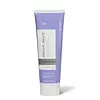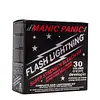What's inside
What's inside
 Key Ingredients
Key Ingredients

 Benefits
Benefits

No benefits
 Concerns
Concerns

 Ingredients Side-by-side
Ingredients Side-by-side

Paraffinum Liquidum
EmollientPotassium Persulfate
Ammonium Persulfate
BleachingSodium Silicate
BufferingSodium Metasilicate
BufferingPetrolatum
EmollientSodium Persulfate
Ethylhexyl Stearate
EmollientSodium Stearate
CleansingKaolin
AbrasiveMagnesium Oxide
AbsorbentSodium Lauryl Sulfate
CleansingSilica
AbrasiveTitanium Dioxide
Cosmetic ColorantHydroxyethylcellulose
Emulsion StabilisingCarbomer
Emulsion StabilisingHydrogenated Castor Oil
EmollientBeeswax
Emulsion StabilisingTetrasodium EDTA
Butylene/Ethylene/Styrene Copolymer
Acrylates/C10-30 Alkyl Acrylate Crosspolymer
Emulsion StabilisingPEG-40 Hydrogenated Castor Oil
EmulsifyingEthylene/Propylene/Styrene Copolymer
Xanthan Gum
EmulsifyingHydrolyzed Keratin
HumectantBisabolol
MaskingCeteareth-30
CleansingHelianthus Annuus Seed Oil
EmollientChamomilla Recutita Flower
Skin ConditioningParaffinum Liquidum, Potassium Persulfate, Ammonium Persulfate, Sodium Silicate, Sodium Metasilicate, Petrolatum, Sodium Persulfate, Ethylhexyl Stearate, Sodium Stearate, Kaolin, Magnesium Oxide, Sodium Lauryl Sulfate, Silica, Titanium Dioxide, Hydroxyethylcellulose, Carbomer, Hydrogenated Castor Oil, Beeswax, Tetrasodium EDTA, Butylene/Ethylene/Styrene Copolymer, Acrylates/C10-30 Alkyl Acrylate Crosspolymer, PEG-40 Hydrogenated Castor Oil, Ethylene/Propylene/Styrene Copolymer, Xanthan Gum, Hydrolyzed Keratin, Bisabolol, Ceteareth-30, Helianthus Annuus Seed Oil, Chamomilla Recutita Flower
Potassium Persulfate
Ammonium Persulfate
BleachingSodium Metasilicate
BufferingSodium Stearate
CleansingSilica
AbrasiveHydroxypropyl Methylcellulose
Emulsion StabilisingXanthan Gum
EmulsifyingDisodium EDTA
Sodium Lauryl Sulfate
CleansingHydrated Silica
AbrasiveWater
Skin ConditioningHydrogen Peroxide
AntimicrobialCetyl Alcohol
EmollientStearyl Alcohol
EmollientTrideceth-2 Carboxamide Mea
Sodium Stannate
StabilisingPhosphoric Acid
BufferingPotassium Persulfate, Ammonium Persulfate, Sodium Metasilicate, Sodium Stearate, Silica, Hydroxypropyl Methylcellulose, Xanthan Gum, Disodium EDTA, Sodium Lauryl Sulfate, Hydrated Silica, Water, Hydrogen Peroxide, Cetyl Alcohol, Stearyl Alcohol, Trideceth-2 Carboxamide Mea, Sodium Stannate, Phosphoric Acid
Ingredients Explained
These ingredients are found in both products.
Ingredients higher up in an ingredient list are typically present in a larger amount.
Ammonium Persulfate is a type of sulfate.
Potassium Persulfate is a type of sulfate.
Silica, also known as silicon dioxide, is a naturally occurring mineral. It is used as a fine, spherical, and porous powder in cosmetics.
Though it has exfoliant properties, the function of silica varies depending on the product.
The unique structure of silica enhances the spreadability and adds smoothness, making it a great texture enhancer.
It is also used as an active carrier, emulsifier, and mattifier due to its ability to absorb excess oil.
In some products, tiny microneedles called spicules are made from silica or hydrolyzed sponge. When you rub them in, they lightly polish away dead skin layers and enhance the penetration of active ingredients.
Learn more about SilicaSodium Lauryl Sulfate (SLS) is a sulfate with surfactant properties.
The surfactant property make it a great foam creator and cleansing agent. Surfactants help bind ingredients that normally do not mix.
Some studies have shown skin irritation due to prolonged SLS use.
Sodium Laureth Sulfate (SLES) is a milder version of SLS.
Learn more about Sodium Lauryl SulfateWe don't have a description for Sodium Metasilicate yet.
Sodium stearate is the sodium salt of stearic acid.
The structure of sodium stearate makes it both a cleanser and emulsifier. As a cleanser, it helps dissolve dirt, oil, and other pollutants. As an emulsifier, it helps prevent ingredients from separating. This adds stability to the formula.
Xanthan gum is used as a stabilizer and thickener within cosmetic products. It helps give products a sticky, thick feeling - preventing them from being too runny.
On the technical side of things, xanthan gum is a polysaccharide - a combination consisting of multiple sugar molecules bonded together.
Xanthan gum is a pretty common and great ingredient. It is a natural, non-toxic, non-irritating ingredient that is also commonly used in food products.
Learn more about Xanthan Gum